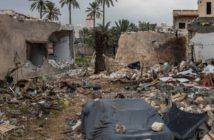Foreign Policy
Posted By Stephen M. Walt
Where is the Middle East headed? Where will it be a decade or two hence? Although most commentary tends to obsess about recent events (Will Assad fall? Was Hezbollah for the bombing in Bulgaria? Will there be war with Iran? Is the two-state solution really dead? etc.) today, I want to step back and ask what the larger implications of these various events might be. Here are three scenarios for the Middle East, judged largely from the perspective of U.S. interests:
1. The Good: The optimistic scenario for the Middle East runs something like this: Although the road may be bumpy for awhile, the various upheavals now subsumed under the heading “Arab spring” mark the end of a long period of regional stagnation. In this view, the Arab world has languished for decades under the bankrupt leadership of a series of autocrats who were better at clinging to power than in developing their societies. Education, scientific competence, economic development and human rights have all suffered as a result. These circumstances have also fueled anti-Americanism and intensified regional tensions, as various entrenched elites have used the bogeyman of “Western imperialism,” Israel’s presence and occupation, and the sufferings of the Palestinians to distract their populations from their own failings.
But in this scenario, that era is coming to an end. Assad will fall the same way Qaddafi did, and his departure will deal a body blow to the “axis of resistance” (Iran, Syria, Hezbollah, Hamas), which is the last stubborn remnant of anti-Western opposition in the region. Weak and isolated, Iran will have no choice but to bow before the West’s demands, and the clerical regime itself will be living on borrowed time. As political change ushers in more responsive and accountable governments throughout the region, the long pent-up energies of these societies will be unleashed and broad-based economic development will begin.
Equally important, the flowering of democracy (or something closer to it) will reduce the current frictions between the United States and some of these societies, as citizens focus on getting educated and getting rich, instead of worrying about red herrings like the Golan Heights, the West Bank, Gaza, or the U.S. military presence in the region. Islam may play a somewhat larger role in political life, but it will be mostly moderate and benign.
This view is consistent with the traditional liberal view of international relations, which tends to dominate how U.S. policymakers think about foreign policy. Liberal theories of IR argue that foreign policy behavior is heavily influenced by societal preferences and regime type, by economic interdependence, and by the creation of powerful global institutions. They tend to assume that human beings mostly care about material prosperity. As Middle East countries become more like us, so the argument runs, conflicts of interest will diminish, anti-Americanism will fade, and interest in obtaining WMD will decline. And once these states become more democratic and fully enmeshed in the world economy, they will drop their outdated objections to Israel and all will be well.
Notice also that this view implies that neoconservatives’ program for “regional transformation” was the right idea all along; the problem was that the people who tried to implement it were incompetent and their chosen instrument — military power and direct U.S. intervention — was simply the wrong tool. Obama’s embrace of the “Arab spring” has been cautious and not always consistent (see under: Bahrain), but it was directed at essentially the same goal and his approach has proven to be far more effective. On balance, he has positioned the United States on the progressive side of change and confined the U.S. role to helping local forces win their battles.
In effect, the administration is betting that the arc of history will bend in a direction that leads to more participatory politics, to greater gender equality and human rights, and to a dramatic reduction in both regional tensions and anti-Americanism over time. It may take a couple of decades for this hopeful vision to be realized, and because massive social change is always messy, there are bound to be some rocky moments along the way. But all Americans need to do is stay the course, use their still-considerable power to nudge these societies in the right direction, and manage the inevitable turbulence for a little while longer.
In many ways, it would be nice if this hopeful future came to fruition, although it would probably consign the Palestinians to another generation or two of impoverished statelessness. Alas, this is not the only scenario one can envision.
2. The Bad: In this version of the future, the political changes unleashed by the “Arab spring” continue to roll forward, and attempts to reimpose the old order (as Egypt’s military seems to be attempting) ultimately fail. Moreover, the emergence of more participatory politics and greater openness do in fact generate many of the positive features described above: education expands, economic development accelerates, and national unity is ultimately strengthened in many of these societies. In short, social and political mobilization continues and deepens, and governments manage to create more open and effective institutions.
But in this scenario, these shifts do not transform the Middle East into a region of calm Kantian liberals, or some Middle Eastern version of the EU. As political dynamism returns to the region, this scenario envisions more and more governments that are both increasingly responsive to popular sentiment and increasingly capable of advancing their national interests (as defined by popular beliefs) on the world stage. And because some of those sentiments are at odds with long-standing U.S. policies, the emergence of a more politically mobilized and capable Arab world might turn out to be a real headache for Washington.
Recent history offers several cautionary warnings. Turkey under the AKP has enjoyed impressive economic growth in recent years — in sharp contrast to the military governments that preceded it — but it has also become a less compliant ally of the United States and increasingly an independent force in the region. U.S. and Turkish interests are often compatible but not always, and that is likely to be true of a post-Mubarak Egypt.
Or consider what has happened to China. If Mao had lived forever, China would still be saddled with a dysfunctional command economy. Embracing capitalism has lifted millions of Chinese citizens out of poverty, but it has also given Beijing the capacity to challenge U.S. leadership on a host of issues, and may one day make it a true “peer competitor.”From a selfishly American perspective, therefore, it might have been better of the “four modernizations” had never occurred and China had remained weak and economically backward. By the same logic, Arab inefficiency is one of the main reasons why the United States and Israel have been able to dominate the Middle East for the past four decades, and we should not blindly assume that a more capable and competent Arab world would also be a more compliant one.
The “good” scenario assumes that the emergence of more participatory, quasi-democratic politics will eventually eliminate the existing conflicts of interest within the region and with the United States. But there are good reasons to question that optimistic belief. Sunni vs. Shiite divisions have been around for centuries and are likely to persist.Palestinians will still press for statehood (or for full voting rights), and politically mobilized Arab publics will continue to back them, in part because this might be an issue that democratic politicians exploit to make themselves more popular at home, as Turkish Prime Minister Recep Tayyip Erdogan was done. A democratic Syrian government will still want the Golan Heights back, and a fully democratic Iran might want nuclear weapons as much as the Shah did or as much as democratic (and nuclear-armed) Israel does.
In this view, in short, we ought to be careful what we wish for.Autocrats like Hosni Mubarak and monarchs like King Hussein or King Abdullah of Jordan could ignore popular sentiment and align closely with Washington, but this may not be so easy for governments that have to depend on popular support. The assumption that progressive political change in the Arab world is a good thing for the United States rests on the belief that “all good things go together”: political change will eventually foster economic development and attenuate existing political disputes. Unfortunately, history also reminds us that as states grow richer and stronger, they often grow more assertive and they start defining their interests in broader terms. This could be big trouble for Washington, given how unpopular U.S. policies have been and how deeply rooted these attitudes seem to be.
3. The Ugly: There is a third scenario, and it is the one we have already seen in Iraq and Lebanon and may now be seeing in Syria. In this version of the future, the Arab spring succeeds in overturning a number of bankrupt orders but does not lead to stable and progressive governance in some of them. Instead, we get weak and divided orders where sectarian quarrels are rife, extremism is rewarded, al Qaeda finds new followers, and those who are adept at violence are advantaged.
Needless to say, this bleak forecast implies that the region will remain messy and divided for many years to come. An economic renaissance will not occur, because political instability will discourage investment and tourism and force local populations to squander time and resources on fighting rather than building. Outside powers will be tempted to intervene in various ways, which will lead to tit-for-tat retaliations and raise the risk of broader regional conflicts.Given that the Gulf region will remain a key source of global energy supplies (no matter how much natural gas the U.S. eventually obtains from hydraulic fracking), continued regional instability could have far-reaching and harmful effects on the world economy.
This scenario isn’t good news for the United States either. It might be smart for the United States to remain aloof from the carnage, but that will be difficult given our interventionist tendencies and the pressure we’ll face from regional allies like Saudi Arabia and Israel. And if the past is any guide, we can’t expect Russia or China or the Europeans to help us quiet things down; they’d rather hand Uncle Sam the burden of managing yet another regional cauldron. So not only would this scenario mean lots of trouble for people in the Middle East, it’s bound to be a big headache for the United States too.
Which of these scenarios do I think is most likely? I lean towards the second, because I don’t think the Arab spring is reversible and because I don’t think that protracted instability in places like Syria will prove all that contagious. But that’s really no more than a hunch.
Of course, these three scenarios are not the only ones one can imagine. But they do help put the current turmoil into perspective, and they help us identify the underlying logic on which current U.S. policy is based. Needless to say, I’ll be delighted if the first scenario is the one we get. I’ll also be more than a little surprised.
.






